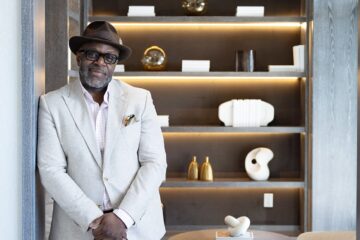A Museum Like No Other
The Aga Khan Museum is one of Toronto’s crown jewels. This great cultural tapestry is all about connecting cultures through art and showing the interconnectivity and storied history of numerous relics dating back centuries.
Fumihiko Maki, winner of the Pritzker Architecture Prize, designed the museum with light as his inspiration, reflecting the importance of patterns and light found in Islamic culture. With its contemporary design and the incorporation of historical elements originating in Islamic cultures, the museum “build[s] bridges between eras as well as civilizations.”
Featured at the museum is a permanent collection gathered by His Highness the Aga Khan and his family over several generations. The permanent collection showcases the breadth of Muslim civilizations from the 8th century to the present day, and includes more than 1,000 artifacts such as rare manuscripts, paintings, ceramics, glass, scientific instruments, intricate metalwork, and carved and painted wood objects.
The aim of the museum is to offer “unique insights and new perspectives into Islamic civilizations and the cultural threads that weave through history binding us together.”
Currently, the Aga Khan Museum is hosting a world premiere exhibition, “Arts of the East: Highlights of Islamic Art from the Bruschettini Collection.” Coming from Genoa, Italy, the collection introduces Canada and international audiences to one of the world’s most important private collections of Islamic art, in an selection exclusive to the Aga Khan Museum.
Arlene Madell, head of marketing and communications for the Aga Khan Museum, says that it is a “rare glimpse of these objects” that otherwise would be nearly impossible for a North American public to see. The collection boasts metalwork, ceramics, textiles and paintings, and carpets magnificent in both size and visual impact, all ranging in origin from the 13th to the 17th century.
Dr. Filiz Çakır Phillip is the curator of this exhibit and together with Dr. Alessandro Bruschettini, hand-picked the 43 objects to be displayed. Highlights of the exhibit include a 13th-century velvet panel from Iran that shimmers with gold discs, an exquisite 16th-century silver bowl, a colourful Ottoman dish, a 16th-century Iranian painting and a unique Mamluk carpet from Egypt.
“These objects are inherently theatrical,” says Gerard Gauci, resident set designer for Opera Atelier. “I want the visitor to feel moved by their beauty and inspired to unravel the stories they have to tell.” The museum wanted someone who has experience in staging to lay out the exhibit, and Gauci is able to “create drama and emotional space for the objects” with his design, says Çakır Phillip.
The “Arts of the East” exhibit “speaks to the core of what the museum is about in connecting cultures through art,” says Madell. Through the pieces, you can see “a Chinese influence… Iranian interpretations, Ottoman synergy [and] Italian collectors,” says Çakır Phillip. The cultural exchange happened as artists, ideas and materials travelled, leading to the transformation of patterns and techniques.
As part of a holiday promotion, the museum is offering exclusive Explore and More passes that grant access to the entire museum, a guided tour, and a drink and baklava from the café. In addition, the pass gives 10 per cent off in the museum’s luxury gift shop, which features artisanal items that are internationally sourced and exclusive to the Aga Khan Museum — making it the perfect place to find something special for the holidays.
Alongside the permanent collection, the “Arts of the East” exhibit and the shop, the Aga Khan Museum offers a variety of other entertaining activities.
The museum has multiple exhibits at the same time. Simultaneous with the “Arts of the East” exhibit is “HERE: Locating Contemporary Canadian Artists,” featuring museum-wide installations of videos, textiles, painting and sculptures; and an outdoor installation in the Aga Khan Park displaying the work of the acclaimed Iranian-Canadian artist Parviz Tanavoli.
A component not normally found in a museum is a state-of-the-art, 350-seat auditorium with a robust performing arts program. The performances show a diverse range of cultural traditions and innovations through music, dance, theatre and film, highlights of which can be seen on the museum’s website. The program specializes in bringing together artists who would not usually perform together, as in the program “All Rivers at Once,” which combines Israeli and Iranian musical performance.
For the foodies, Diwan is the museum’s in-house restaurant, open for lunch only, and features dishes inspired by the exhibits themselves. Diwan too has art on display, with installations of late 18th-century wooden painted panels as part of the restaurant’s permanent decor.
The Aga Khan Museum is the epitome of converging cultures. Not only does the museum depict the storytelling and cultural journey of historical artifacts, but it also shows how cultures have been intertwined for centuries. In doing so, the museum presents a beautiful tableau of the modern Canadian landscape, rich with diverse narratives and inspirational and influential perspectives.
With its exclusive items, its cultural emphasis, and what it stands for and showcases — not just Islamic culture but also intermixed worldviews and esthetics — the Aga Khan Museum is truly “a museum like no other.”























































































No Comment